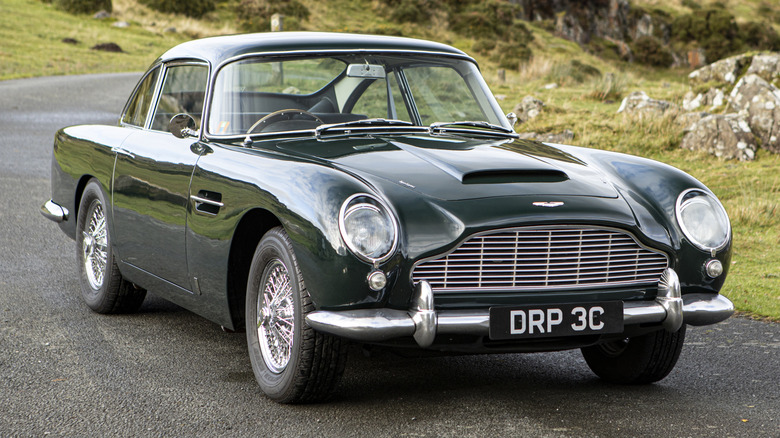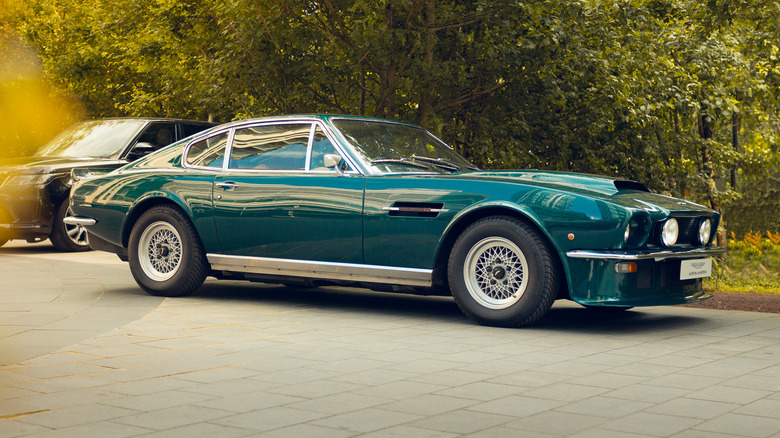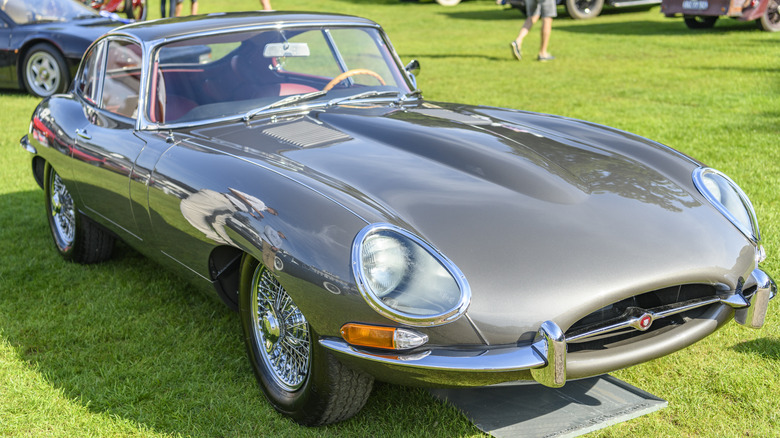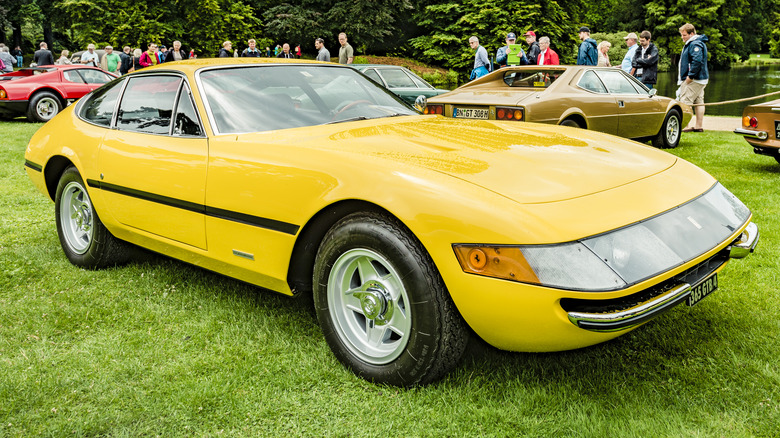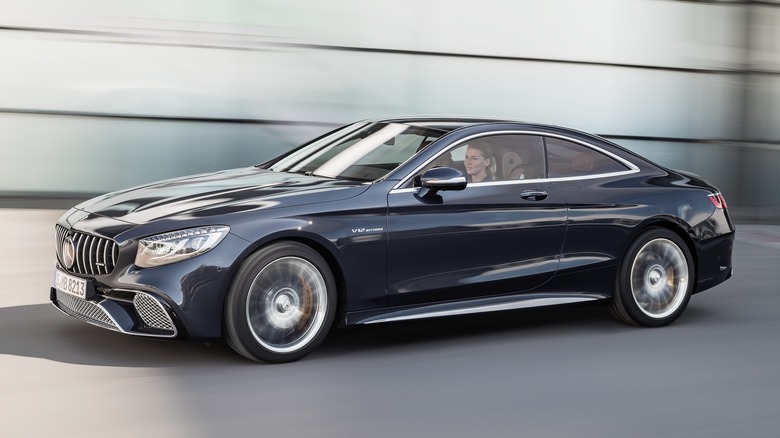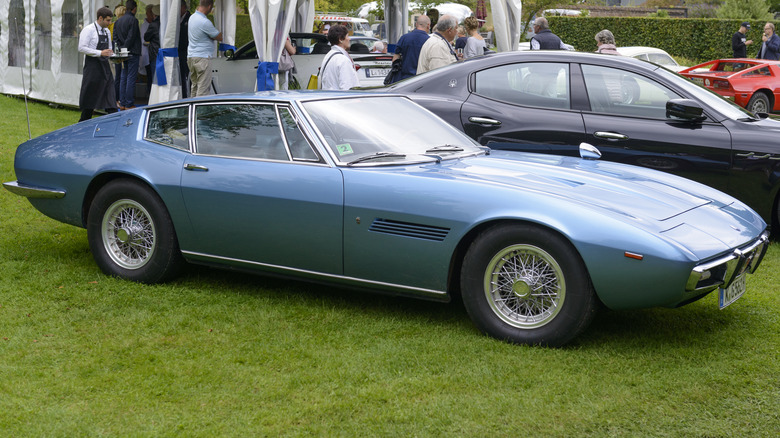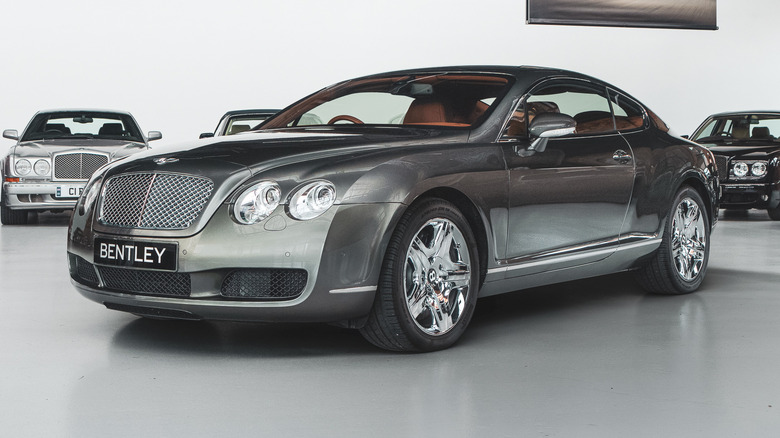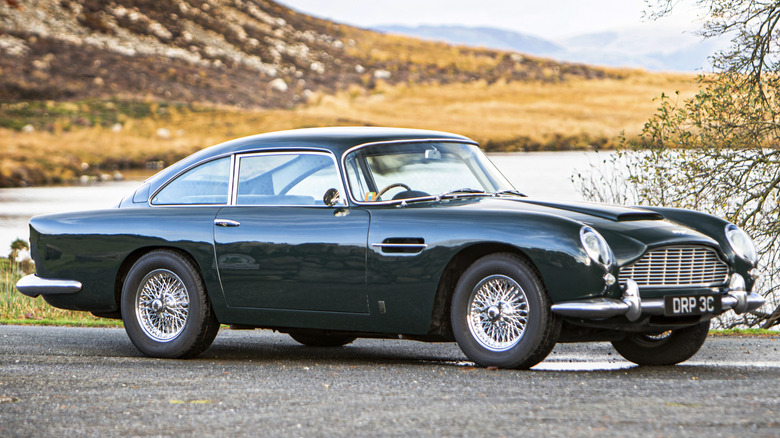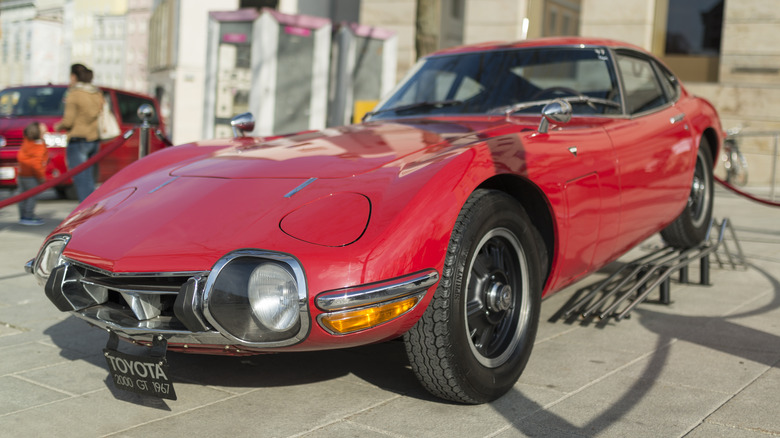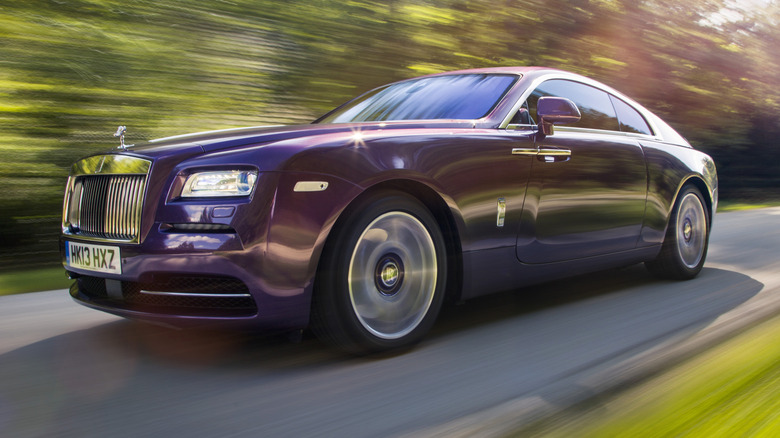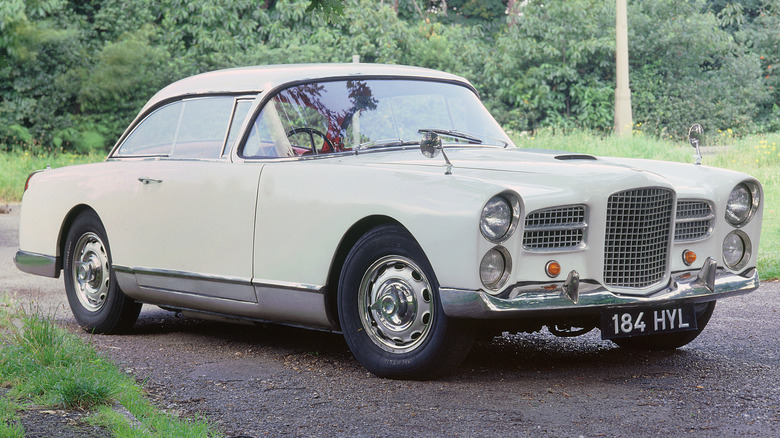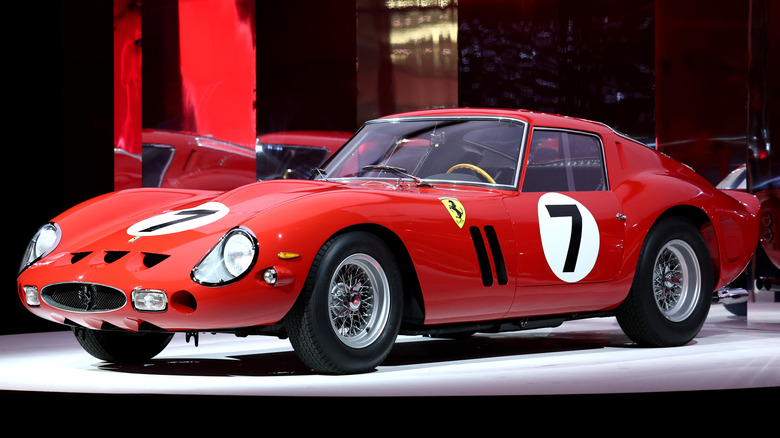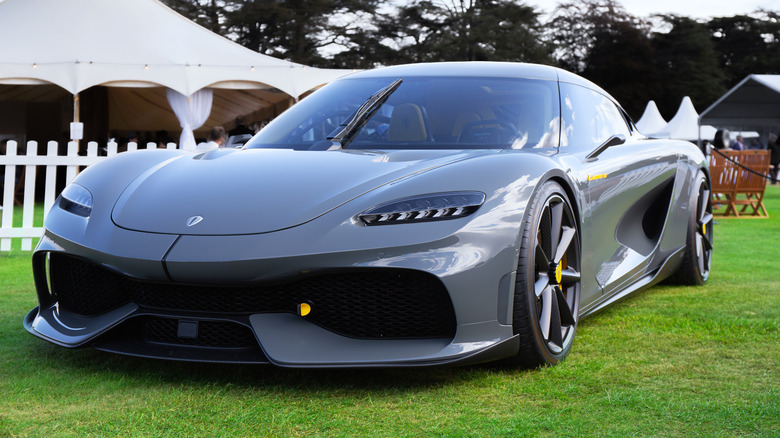12 Of The Coolest Grand Touring Cars Ever Built
The letters GT crop up in a huge range of automotive segments, from the VW Golf GTI to the Ford Mustang Mach-E GT. In almost all cases, the letters stand for "grand touring" — or the Italian "gran turismo," from where the English phrase is originally derived. Arguably, neither of the cars previously mentioned bear any relation to the original meaning of the term, and neither do many of the modern cars that feature GT badging. In the traditional sense, grand touring cars are those built to blend the attributes of a sports car with those of a luxury car, providing the best of both worlds.
They're designed to be well-appointed and comfortable to drive but also powerful and athletic. That makes them excellent for long-distance road trips as well as high-speed driving. Sports cars, by comparison, are traditionally engineered primarily for the latter, while luxury cars focus on comfort over performance. The grand tourer designation stretches back to the days of the European post-war auto industry, and there have been countless GT models produced since. With that in mind, we've rounded up 12 of our favorites that stick out as particularly cool examples of the segment, from classics to cutting-edge cars.
Aston Martin V8 Vantage '77
The original Aston Martin "brute in a suit," the 1977 V8 Vantage mixed British craftsmanship and luxury with uncompromising V8 power. It was designed to maximize the power output of the engine found in the Aston Martin V8, pushing horsepower figures up by 40% while maintaining the original car's mile-munching long-distance comfort. With up to 380 horsepower on offer, the car boasted a 0-60 mph time of 5.2 seconds and a top speed north of 170 mph.
It's often credited as the first British supercar, although its four seats and generous luggage space offered more everyday practicality than the term supercar might imply. This wasn't simply a track day toy or a technical showcase – despite being the world's fastest four-seater at the time of its release, this was very much still a plush drivers' car built with long road trips in mind.
Not all V8 Vantages were built equal, however. Due to restrictive emissions regulations, American-market examples were initially sold without the boost in power over the standard V8 coupe, although most have been retrofitted in the decades since to match their European counterparts. All the other Vantage upgrades, from the new suspension to the unique body kit, remained the same across all markets.
Jaguar E-Type
While the Aston Martin V8 Vantage may well have been Britain's first supercar, it certainly wasn't Britain's first grand touring icon. The country's carmakers had been experimenting with combining luxury and performance since the post-war days, with the Jaguar E-Type one of the most successful creations.
The car debuted at the 1961 Geneva Motor Show and attracted so much interest from customers and the media that the company's sole demonstration car was fully booked out. To accommodate the overwhelming demand, a Jaguar engineer drove a second test car from the marque's base in Coventry, England to the Swiss motor show overnight. In a testament to its grand touring pedigree, the car completed the 700-mile journey with time to spare, arriving at the show in time for test drives to commence the following morning.
Alongside its impressive performance -– Jaguar claimed a 150 mph top speed –- the E-Type's styling also set it apart from its peers. Enzo Ferrari famously called it "the most beautiful car in the world," and over the years, its flowing lines have remained just as striking. The icing on the cake for buyers at the time was that the E-Type was also significantly more affordable than many of its contemporaries, with a price that equates to around $50,000 in today's money.
Ferrari 365 GTB4 Daytona
The Ferrari "Daytona" took its nickname from the dominant 1-2-3 finish that the automaker achieved at the 1967 24 Hours of Daytona, but officially, it was only ever known as the 365 GTB4. It was developed in both road-going and race-spec variants, with the latter proving to be particularly dominant at Le Mans. The Daytona won its class at Le Mans three years consecutively between 1972 and 1974, putting on a particularly dominant performance in '72, when it took the first five places in its class.
Aside from its success on the track, the Daytona also proved to be an exceptional road car, offering both fierce performance and a comfortable, elegant cabin. Performance varied slightly depending on region, with American-market cars bound by stricter regulations and, therefore, slightly slower than Euro-spec cars.
Still, their timeless design and status as one of Ferrari's best cars from the era have kept prices consistently high for collectors in recent years. Most publicly sold examples fetch over half a million dollars, with the most pristine examples costing $800,000 or more.
Mercedes-Benz S-Class Coupe
Alongside the classics, there are a number of more modern grand tourers that also deserve a spot on this list. One such car is the current generation S-Class Coupe, whose name sums up its appeal — it combines the luxury and technology of the S-Class limousine with the looks and handling of a coupe.
The S-Class line is famous for its use of cutting-edge tech, and the S-Class Coupe didn't disappoint. The headline features all centered around ride comfort. For instance, there was Magic Body Control, which used a series of cameras to assess the road surface ahead and adapt the suspension to match, as well as a luxury lounge cabin with optional Nappa leather upholstery. Three variants were made available at launch, the most powerful of which was the 621 horsepower AMG S65. The top-spec car featured a 6.0L V12 engine, while all other variants packed a V8 under the hood.
Despite superseding the SL line as the flagship Mercedes grand tourer, the S-Class Coupe's production run was short-lived. Production was axed after 2021 as the brand slimmed down its lineup, leaving the current-generation SL its closest replacement.
Maserati Ghibli
The Ghibli nameplate is unusual among Maserati's back catalog as it has been revived twice over the years, and both of those revivals are very different from the original. Arguably, it's the original grand tourer that's still the greatest incarnation to bear the name, with its production run spanning from 1967 to 1972. Designed by Giorgetto Giugiaro, the Ghibli was a traditional GT car in that it featured a 2+2 seating layout, a luxurious cabin, and enough luggage space to store weekend bags for a road trip.
The car's V8 engine was shared with other Maserati models, including the four-door Quattroporte sedan, and made either 330 or 335 horsepower depending on configuration. In its most potent Ghibli SS form, it could reportedly reach a top speed of 177 mph. Over 1,300 examples were built in total, with the spyder variant much rarer than the coupe.
Widely considered one of Giugiaro's greatest designs, the car's engine featured a dry sump to accommodate the sloping hood. Pop-up headlights also kept the hood line uninterrupted, giving the front end a sleek, flowing appearance.
Bentley Continental GT
Few modern grand tourers have shaped the history of an entire brand as much as the Bentley Continental. The modern Continental GT, unveiled in the early '00s, marked a turning point for the brand -– freshly revived under VW Group ownership, Bentley proved it could still make a world-class performance car without compromising on the sense of luxury on which it had built its reputation. The car was significantly faster than its predecessor, boasting a W12 engine and a more aerodynamic styling.
Its success, both critically and commercially, helped Bentley transform its image and its bottom line. The modern Continental GT still follows a similar formula to that of the relaunched 2003 car, which is a testament to the original's design. High running costs and traditional British (read: questionable) reliability have helped keep used values low, although given the car's importance to Bentley as a brand, it may well become more collectible in the future.
Aston Martin DB5
One of the best-known grand tourers thanks to its iconic role in the classic James Bond film "Goldfinger," the Aston Martin DB5 is both very rare and very valuable today. It featured a 4.0L straight-six engine making 282 horsepower, enough to propel the car to an officially quoted top speed of 150 mph. Its high-performance engine was complemented by a highly sophisticated cabin, with journalists from the era comparing its high-tech dashboard to that of an aircraft. However, the standard car paled in comparison to the technology available in James Bond's highly modified example.
Although none of the original 900 or so customer DB5s could be optioned with Bond gadgets, a limited continuation run launched in 2020 gave buyers a chance to get behind the wheel of their own movie-grade car. Featuring extras like bulletproof glass, replica machine guns, and built-in battering rams, each DB5 Goldfinger Continuation took 4,500 hours to construct. A run of just 25 examples were built, all of which were quickly snapped up.
Even without its big-screen gadgets, the DB5 remains an extremely desirable collector's car, as well as one of the most capable grand tourers of its era. Unfortunately, its fame now means that few examples will still be used as originally intended — for long road trips and high-speed jaunts across the country. Rather, they'll likely be confined to air-conditioned garages as museum pieces, all while their value continues to increase.
Toyota 2000GT
A landmark car in Japanese automotive history, the Toyota 2000GT was the first car to prove that the country's automakers could build a true performance vehicle. It was designed as a response to Japan's burgeoning racing scene, with the goal of making a car just as capable on the road as it was on the track. With Toyota lacking the production facilities to build such a bespoke car, Yamaha was contracted to build both the prototype and production units.
The car was first unveiled in 1965 but was only launched for public sale in 1967. It proved to be a relatively slow seller –- wealthy domestic buyers were still unsure about the competitiveness of a Japanese grand tourer, and there was virtually no interest in the car outside its home market. In total, a reported 337 road cars were built, plus a handful for racing use. Each car was powered by a 2.0L straight-six engine making 150 horsepower, enough for a top speed of 136 mph.
While they never saw sales success at the time, their iconic status has made them highly sought-after collectors' cars today. Examples don't often appear for public sale, but when they do, they tend to fetch anywhere between $500,000 and $1,000,000.
Rolls-Royce Wraith
While previous Rolls-Royces had remained firmly in luxury car territory, the Wraith took a new direction and focused on driver enjoyment as much as pure luxury. As such, it's considered to be the first modern-era Rolls-Royce grand tourer.
While traditionally, Rolls-Royce was never keen on showing off performance figures for its cars, once even famously describing the output of its Silver Shadow as "adequate," the press release for the Wraith was a different matter. Its 624 horsepower engine and 4.4 second 0-60 mph time were among the first details disclosed about the car, alongside the typical description of its luxurious cabin.
When driving the Wraith, we were struck by how quiet and refined it remained even through more spirited driving. It's no doubt one of the most tranquil ways to embark on a cross-country jaunt should the situation call for it. A unique kind of grand tourer, then, and one that still errs closer to the luxury than the performance side of the segment. Make no mistake, however — this is still a seriously rapid car, one that we found frighteningly easy to hit license-losing speeds in as we cruised down the highway.
Facel Vega HK500
While the longevity of brands like Ferrari, Jaguar, and Aston Martin has ensured their greatest grand tourers remain in the limelight, not every vintage icon has been so lucky. The Facel Vega HK500 was among the most desirable cars of its day, with a laundry list of celebrity owners stretching from Pablo Picasso to Sir Stirling Moss. However, in the decades since the Facel brand folded, it's remained under the radar compared to many of its contemporaries.
It's thought that roughly 490 examples of the car were built over its production run, although it's unknown how many of those survive to the present day. The HK500 was an upgraded version of the Vega FVS, boasting a more powerful, Chrysler-sourced V8 engine. It produced a reported 360 horsepower and could reach a top speed in excess of 140 mph.
The upgraded car was introduced in 1959 but wasn't in production for long. By 1964, the Facel brand had shuttered altogether, marking an unceremonious end for one of the greatest French grand tourers ever made.
Ferrari 250 GTO
Described by Ferrari as "the ultimate expression of the Ferrari 250 GT car," the 250 GTO is also among the most valuable Ferrari cars ever produced. Part of that is down to its rarity, as just 36 examples were made. The car was originally developed by Giotto Bizzarrini as a rival to the Jaguar E-Type, but its development was interrupted by the infamous Ferrari revolution of 1961.
Following a heated disagreement with Enzo Ferrari, Bizzarrini was fired, along with several other key staff members. That left designer Sergio Scaglietti, another legendary name in Ferrari's history, to polish the design so it was ready for road car production to begin. The car was designed to be suited for both high-performance road driving and circuit competition, and many of the surviving 250 GTOs can claim some degree of racing pedigree.
While it's no longer the outright most expensive car in the world, the best examples of the 250 GTO continue to fetch eye-watering sums at auction. In 2022, a previously single-family-owned example sold for an astonishing $38.1 million.
Koenigsegg Gemera
The Koenigsegg Gemera is not like other grand tourers. It can still seat four and has room for a modest amount of luggage, and it even comes with an optional V8 engine. However, that V8, along with ample assistance from the car's electric motors, makes a combined 2,300 horsepower. For context, that's more than twice as much as the original Bugatti Veyron. Yet, the Koenigsegg can still transport a small family.
The Gemera is simulteneously the most sensible and the most outlandish Koenigsegg made to date, and it sports a suitably outlandish asking price. It's been reported that the V8 Gemera will cost at least $2.1 million, representing a $400,000 premium over the standard 1,400 horsepower variant. Its performance stats make it difficult to define: as a four-seater, two-door hybrid, it follows the formula for which many GTs of the future will undoubtedly follow, yet with its ridiculous four-figure power output, it's also one of the most groundbreaking — not to mention exclusive — hypercars ever built.
Whether it will be just as comfortable and engaging to drive as the best classic grand tourers remains to be seen for now, but one thing is for certain — for crossing continents in a hurry, nothing short of an airplane is better suited for the job.
